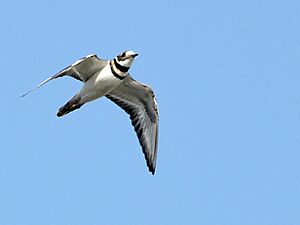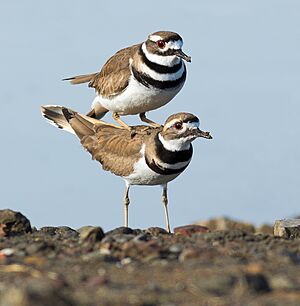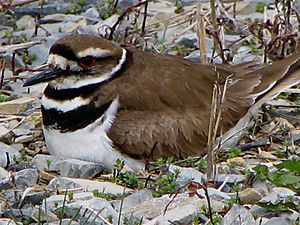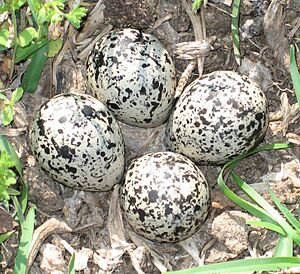Killdeer facts for kids
Quick facts for kids Killdeer |
|
|---|---|
 |
|
| A Killdeer in its breeding colors. | |
| Conservation status | |
| Scientific classification | |
| Genus: |
Charadrius
|
| Species: |
vociferus
|
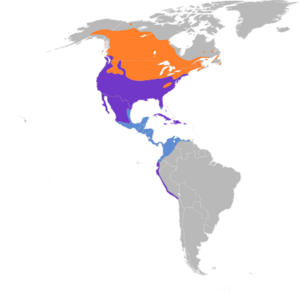 |
|
| Breeding range Resident range Non-breeding range | |
The killdeer (Charadrius vociferus) is a large plover bird. It lives in North and South Americas. This bird gets its name from its loud, two-part call, which sounds like "kill-deer". A famous scientist named Carl Linnaeus first described it in 1758.
There are three types, or subspecies, of killdeer. Most killdeer have brown backs and wings with reddish edges. Their heads have white and black patches. They also have two black bands across their chest, with a white belly. The main type of killdeer lives from Alaska and Canada down to Mexico. Some killdeer stay in these areas all year. Other types live in the West Indies and parts of South America. Killdeer from North America fly south for winter. They go to Central America, the West Indies, and northern South America.
Killdeer live in open fields with short plants. They can also be found in coastal wetlands and on beaches. Even though they are called "shorebirds," they don't always nest near water. Their nest is a simple dip in the ground. It is lined with plants and white things like small stones or seashell pieces. Female killdeer lay four to six eggs. The eggs are light brown with dark spots. They lay eggs from mid-March to August. Both parents take turns sitting on the eggs for about 22 to 28 days. The baby birds leave the nest the day after they hatch. Their parents lead them to a feeding area where they find their own food. Young killdeer learn to fly about 31 days after hatching. They can start having their own babies when they are one year old.
Killdeer mainly eat insects. They also eat other small creatures and seeds. They look for food in fields, especially those with short grass. They like fields where cattle graze or where there is standing water. Killdeer usually hunt during the day. But when the moon is full, they might hunt at night. This is probably because there are more insects out and fewer predators at night. Many birds and mammals hunt killdeer. Killdeer have special ways to protect themselves from danger. They might make loud calls or do a "broken-wing display." This display makes them look hurt to distract predators. The killdeer is not an endangered bird. Its population is large, but it is slowly getting smaller. Laws in America and Canada protect this bird.
Contents
What's in a Name?
The killdeer was first described in 1758 by a Swedish scientist named Carl Linnaeus. He gave it the scientific name Charadrius vociferus. This is the name it still has today. Linnaeus based his description on notes from an English scientist, Mark Catesby. Catesby had called it the "chattering plover."
The name Charadrius comes from an old Latin word. It means a yellowish bird mentioned in an ancient Bible. This word came from an even older Greek word. It described a bird found in ravines and river valleys. The second part of the name, vociferus, is Latin. It means "loud-crying" or "noisy." This fits the killdeer's loud call!
There are three main types of killdeer:
- C. v. vociferus – This is the most common type. It lives in the US (including Alaska), southern Canada, and Mexico. It can be found as far south as Panama. In winter, it flies to northwestern South America.
- C. v. ternominatus – This type lives in the Bahamas, the Greater Antilles, and the Virgin Islands.
- C. v. peruvianus – This South American type lives in western Ecuador, Peru, and northern Chile.
The common name "killdeer" comes from its loud, often heard call.
How to Spot a Killdeer
The killdeer is a large plover. Adult birds are about 8 to 11 inches long. Their wings can spread out to about 23 to 25 inches wide. They usually weigh between 2.5 and 4 ounces. They have a short, thick, dark beak. Their legs are flesh-colored, and they have a red ring around their eyes.
Their backs and wings are mostly brown with reddish edges. They have a white forehead and a white stripe behind each eye. The areas around their eyes are black. Killdeer also have a white collar with a black line above it. The rest of their face is brown. Their chest and belly are white. They have two black bands across their chest. The killdeer is the only plover in North America with two chest bands. Their rump (the area above the tail) is red. Their tail is mostly brown with a black band near the end and a white tip. When they fly, you can see a white stripe on their wings.
Female killdeer usually have browner face masks and chest bands than males. The C. v. ternominatus type is smaller and paler. The C. v. peruvianus type is also smaller. It has more reddish feather edges. Young killdeer look similar to adults. Baby killdeer are dusky and light brown on top. Their undersides, forehead, neck, and chin are white. They have only one band across their chest.
Killdeer are very noisy birds. They call even at night. Their calls sound like "deee," "tyeeee," and "kil-deee." When they fly to show off, they repeat "kil-deer" or "kee-deeyu." If they are bothered, they make quick sounds like "kee-di-di-di." Their alarm call is a long, fast trill.
Where Killdeer Live
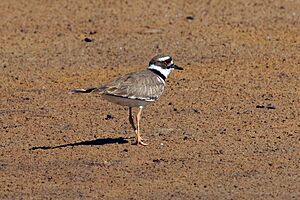
The main type of killdeer breeds in the US (including Alaska), southern Canada, and Mexico. Some northern groups fly south for winter. This bird lives all year in the southern half of its breeding range. This includes most of the central and southern United States. They spend winter in Central America, the West Indies, Colombia, Ecuador, and islands near Venezuela. They leave their breeding grounds after mid-July. Most migrate from August to September. They return to their breeding grounds from February to mid-May.
The C. v. ternominatus type lives all year in the Bahamas, Greater Antilles, and Virgin Islands. The C. v. peruvianus type lives all year in western Ecuador, Peru, and northern Chile.
Killdeer use beaches, coastal wetlands, and fields when they are not breeding. They mostly look for food in these fields. They especially like fields with short plants. They also like fields where cattle graze (which keeps the grass short) and where there is standing water. Killdeer usually live in low-lying areas. But during their autumn migration, they can be found in meadows and open lake shores up to the snowline.
Killdeer Behavior
Reproduction and Life Cycle
Killdeer form pairs when they arrive at their breeding areas. Both males and females (but males more often) call loudly while flying to attract a mate. The male also calls from high spots. He scrapes out pretend nests and flies slowly over his territory. If another killdeer comes too close, they might chase each other on the ground or in the air. This is how they protect their territory.
Killdeer build nests in open fields or flat areas with short plants. They might also nest on rooftops. They often nest in the same area each year. The male usually returns to the same spot, even with a new mate. The female might not use the same territory if she has a different mate. The nest is a shallow dip in the ground. It is lined with small stones and grass. They often use white nesting material. Scientists think this helps keep the nest cool or hides it better. When nesting on rooftops, they might choose a flat roof. They sometimes build a nest of raised gravel, lined with white pebbles or seashells.
Killdeer eggs are usually laid from mid-March to early June in warmer areas. In northern areas, they lay eggs from mid-April to mid-July. The breeding season lasts until about August. In Puerto Rico and other Caribbean islands, they might breed all year.
Killdeer usually lay four to six eggs. The eggs are light brown with brown marks and black spots. They are about 1.5 inches long and 1 inch wide. Eggs are laid every 24 to 48 hours. Both parents work hardest during egg-laying. The female needs energy to make eggs. The male needs to protect their territory. Both parents stay close to the nest during egg-laying and incubation. The male is usually closer, likely because he protects the nest more. They can lay up to five sets of replacement eggs if the first ones are lost. Sometimes, they have two broods of babies in one season. The second brood is usually in the same nesting area. Both parents sit on the eggs for 22 to 28 days. The male often sits on the eggs at night. When it's hot, parents shade the eggs to keep them cool.
About half of the eggs are lost, mostly to predators. Baby killdeer can walk soon after they hatch. Both parents lead them out of the nest. They go to a feeding area with thick plants where the chicks can hide from predators. Both parents usually raise the young. This is important because many nests fail. One parent usually watches the chicks at a time, often the female. The other parent stays about 75 feet away. When the chicks are very young, the parent watching them spends little time feeding. As the chicks grow, the parent spends more time finding food. The parent who is not watching the chicks defends them most when they are less than a week old. This job slowly shifts to the parent who is watching them. Parents brood (sit on) the chicks often until they are two days old. They brood them during the day for about 15 days and at night for about 18 days. The only time chicks are alone is when parents are mating or dealing with a predator.
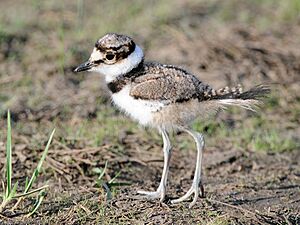
If a pair has two broods, the male usually raises the second brood alone. He can hatch the eggs by himself. He spends more time foraging as the young get older.
Young killdeer learn to fly about 31 days after hatching. They often move to wetter areas near rivers. Their parents might care for them for up to 10 days after they can fly. Sometimes, they are cared for for much longer. About half of nests do not produce any young that can fly. Killdeer start breeding when they are one year old. They can live up to 10 years and 11 months.
Feeding Habits
Killdeer mostly eat insects, like beetles and flies. They also eat millipedes, worms, snails, spiders, and some seeds. Sometimes, they eat tree frogs and dead small fish. They almost always look for food in fields. They prefer fields with short plants, especially where cattle graze and there is standing water. Standing water alone doesn't affect their choice of field much unless cattle are also there. Killdeer can spread seeds of water plants through their droppings.
Killdeer use their eyes to find food. One way they hunt is called "foot-trembling." They stand on one foot and shake the other in shallow water for about five seconds. Then, they peck at any prey that gets stirred up. When feeding in fields, they sometimes follow plows. This helps them find earthworms brought to the surface. During most of the breeding season, the female hunts more than the male. She feeds the most before and during egg-laying. She feeds the least when she starts sitting on the eggs. Then, she goes back to feeding a lot after the eggs hatch. When they are not breeding, killdeer hunt at night, especially when the moon is full. Hunting at night helps them find more insects and avoid predators.
Who Hunts the Killdeer?
Killdeer can have tiny parasites like worms. Many animals hunt killdeer. These include herring gulls, crows, raccoons, and striped skunks. Birds are the main predators in some areas during breeding season. Predators don't just eat eggs and chicks. Animals like weasels can also kill adult killdeer sitting on their nests.
How Killdeer Protect Themselves
Parents use different ways to distract predators during breeding season. One way is the "broken-wing display." This makes them look like they are hurt. First, the bird runs from its nest, making loud alarm calls. When the predator is watching, the bird turns its tail towards it. This shows off the bright orange color of its rump. Then, it crouches down, droops its wings, and lowers its tail. As the danger increases, they hold their wings higher and fan out their tail. Another behavior is the "ungulate display." The adult raises its wings, shows its rump, lowers its head, and charges at the intruder. This can be very dangerous for the bird doing the display.
- The broken-wing display
How strongly killdeer react to predators changes during the breeding season. When they are laying eggs, they usually just quietly leave the nest. As they start and continue to sit on the eggs, their reaction to predators gets stronger. It is strongest after the babies hatch. This is probably because the young are more likely to survive then, so they are worth protecting more. After the babies get older, their reactions become less intense. This is because the young become more independent.
Killdeer Status
The killdeer is considered a "least concern" species by a group called the IUCN. This is because it lives in a very large area, about 10 million square miles. Its population is estimated to be around one to two million birds. Even though the number of killdeer is going down, it's not dropping fast enough to be considered a vulnerable species. Laws protect the killdeer in the US, like the Migratory Bird Treaty Act of 1918. In Canada, it's protected by the Migratory Birds Convention Act.



